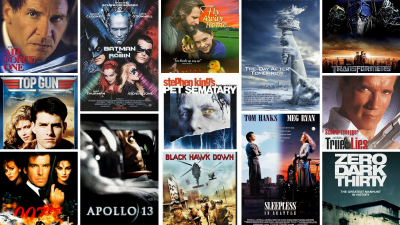Here Are 410 Movies Made Under the Direct Influence and Supervision of the Pentagon

Note to readers: please click the share buttons above
A year ago we featured a detailed report by authors Tom Secker and Matthew Alford exposing just how vast the Pentagon and CIA programs for partnering with Hollywood actually are, based on some 4,000 new pages of formerly classified archived documents obtained through the Freedom of Information Act.
The report noted at the time that
“These documents for the first time demonstrate that the US government has worked behind the scenes on over 800 major movies and more than 1,000 TV titles.”
Reviewing the ever expanding list, the average movie watcher might be in for a shock at what films are actually included — there are the more predictable ones like Black Hawk Down, Zero Dark Thirty, and Lone Survivor; but also entirely unexpected ones that apparently needed the military-industrial complex’s propaganda touch like Earnest Saves Christmas, Karate Kid 2, The Silence of the Lambs, Twister, the Iron Man movies, and more recently Pitch Perfect 3.
When a Hollywood writer or producer approaches the Pentagon and asks for access to military assets to help make their film, they have to submit their script to the entertainment liaison offices for vetting. Ultimately, the man with the final say is Phil Strub, the Department of Defense’s (DOD) chief Hollywood liaison, who has been at the helm of this formerly semi-secret department going all the way back to 1989.
If there are characters, action or dialogue that the DOD doesn’t approve of then the film-maker has to make changes to accommodate the military’s demands. If they refuse then the Pentagon packs up its toys and goes home. To obtain full cooperation the producers have to sign contracts, called Production Assistance Agreements, which lock them into using a military-approved version of the script.
The Pentagon directly influences Hollywood — in some cases, scripts are literally line edited by the military. Part of my last book was all about this — I call it the Military-Entertainment Complex. Read this WashPost piece I did summarizing the situation: https://t.co/pT95fQcmPh https://t.co/fudXSJaG9a
— David Sirota (@davidsirota) August 4, 2018
Months ago, Strub was again profiled in a report called Elisting an Audience: How Hollywood Peddles Propaganda, which quoted him trying to push back against the growing media exposure over the past year:
“We’re not trying to brainwash people! We’re out to present the clearest, truest view,” Strub told The Outline.
The report rightly noted that while Americans generally pride themselves on living in a free speech anti-censorship society, while simultaneously mocking the propaganda examples in places like Russia or China, the US public is subject to more homegrown state-run propaganda than it thinks:
Military pageantry in Russia, massive rallies in North Korea, blunt messaging from China. We cluck at shameless self-aggrandizing when we see it overseas. But it doesn’t take much effort to see that American propaganda is everywhere, too. It’s not government-made, and it’s not quite as brazen as its counterpart from abroad. But it’s here, and to ignore that a piece of content is, at its core, propaganda — especially these days, while Trump openly pines for grand army parades — is a mistake. “There’s all kinds of ways to make an ideological point,” Harris added. “Sometimes I do think we’re not attuned enough. We do not look hard enough for propaganda.”
And what’s more, unlike in authoritarian systems, in the West it is the consumers that are actually willing, if perhaps unwitting, participants in state propaganda. The Outline report continues:
Certainly, the content has alternative, sincere agendas, too, but it’s the giant, amorphous market of consumers that has called it forth. That’s the difference between our propaganda and everyone else’s. In autocratic regimes, a government-backed entity pushes it onto indifferent or unwilling consumers. In America, we, the consumers, happily demand it.
Want to see what Hollywood films — some recent and some going back decades — that you’ve seen but were unaware had the US Department of Defense’s official imprimatur?
* * *
Below is a merely partial list of films in alphabetical order that had Pentagon involvement either during the script or production phase, according to declassified US government documents. Amazingly the list of 410 movies is but half of the total number (for example, Zero Dark Thirty and some other prominent ones are not on there) and was compiled by the FOIA investigative website Spy Culture.










*
Featured image is from Zero Hedge.

